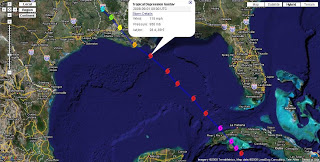Gustav Gives US A Break

Hurricane Gustav’s track and wind history, courtesy of Weather Underground
Too soon to say for sure — we haven’t yet seen any of the satellite images of the Gulf that were taken in the wake of Hurricane Gustav last week — but we haven’t heard of any offshore or onshore oil spills like those following Hurricane Katrina in 2005. One drill-rig operator, Transocean, reported some damage to three of their offshore drill rigs; one suffered damage to it’s mooring system, not good news considering that mooring systems were supposedly beefed up after Katrina blew a bunch of rigs around the Gulf. Let’s compare the two storms: Gustav was a Category 3 storm out in the northern Gulf, while Katrina was a monster Cat 5. Gustav hit the offshore oil fields with maximum sustained winds of 115 mph. Katrina moved through the OCS with maximum sustained winds of 175 mph, gusting to 215 mph, with hurricane-force winds reaching 105 miles from the eye. Katrina generated 100-foot waves in the Gulf, high enough to batter the upper decks of major production platforms. At landfall, Gustav was a strong Cat 2 (110 mph) and Katrina was a strong Cat 3 (125 mph sustained, with gusts over 140 mph). Damage increases exponentially with increase in category – a Cat 4 could be 250 times as damaging as a at 1. Katrina was the 6th strongest Atlantic hurricane in recorded history.
Since the OCS platforms are designed to withstand at least a Cat 3 storm, they better not get beat up by the likes of Gustav. A Cat 4 or 5 storm is a whole ‘nother ballgame. Let’s hope Hurricane Ike doesn’t give us that test.



